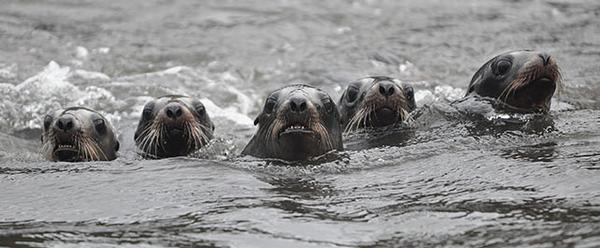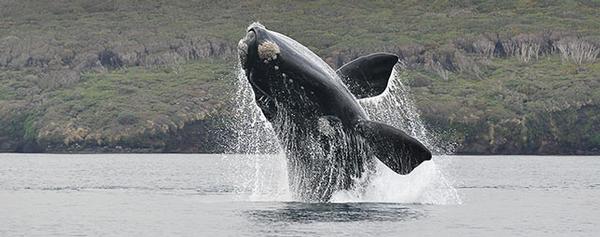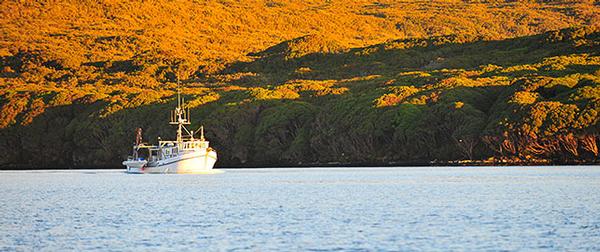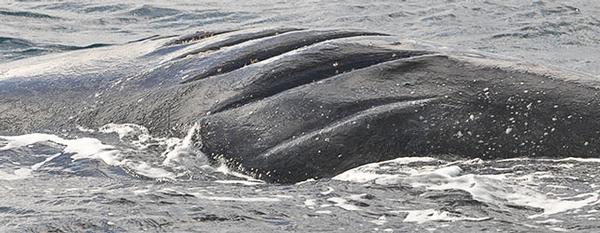Expedition returns wealth of data on whales, sea lions and birds
A University of Otago led multi-disciplinary expedition to the Sub-Antarctic Auckland Islands has recently returned with an abundance of scientific data on whales, sea lions and birds, but also evidence of ship-strike on a Southern Right Whale.
The expedition of 12 scientists and crew from Otago, Massey University and the National Oceanic and Atmospheric Administration (NOAA) in the USA, returned in mid August from their 25-day expedition aboard the University of Otago vessel Polaris II.
Expedition leader from Otago’s Marine Science Department Dr Will Rayment says the aims of the expedition were to study the recovering population of Southern Right Whales in the Auckland Islands, the diet of New Zealand sea lions and the foraging behaviour of yellow-eyed penguins and Auckland Island shags.
Southern Right Whales visit the Auckland Islands during the winter, seeking sheltered habitat to give birth and nurse their calves.
“We saw very high densities of whales in Port Ross, the sheltered harbour at the northern end of the islands. We conducted photo-ID surveys on 21 days yielding more than 8000 digital images. These will be analysed to estimate population size and growth rate,” says Dr Rayment.
“Sadly we also witnessed a whale that had been struck by a ship – evidenced by the succession of scars across its back from the ship’s propeller.
“We can tell it’s a propeller strike because of the regular, repeated pattern of scarring. In this case it seems that the propeller cut into the whale’s thick blubber layer, which healed but left large scars. In more serious cases the cuts can result in serious fractures or penetrate vital organs. This animal is lucky to survive this encounter.
“This is the first time we have seen a southern right whale in NZ waters with prop scars, and is a timely warning about the impacts the whales will face as their range overlaps more with human activities.”
Ship strike is the leading cause of mortality in the closely related North Atlantic right whale.
The good weather also meant the conditions were ideal for making acoustic recordings of right whale vocalisations. PhD student Trudi Webster made over 40 hours of recording with a hydrophone to gather data on vocal behaviour of right whales.
The team also recovered an autonomous seabed mounted acoustic recorder deployed over the previous year which has yielded over 850 hrs of recordings that will be used to investigate timing of arrival and departure of whales from the wintering grounds. The right whale research team also includes Otago Associate Professor Steve Dawson and science student Anthony Davidson, and Tim Cole, from NOAA.
Dr Chris Lalas from Otago’s Marine Science department and Helen McConnell of Massey University also investigated aspects of the winter diet of New Zealand sea lions from a collection of over 400 regurgitations of indigestible prey remains. Dr Lalas says their aim was to document their diet for the first time in winter.
The sea-bird research was led by Dr Hiltrun Ratz, resident scientist at Penguin Place on the Otago Peninsula.
“The unusually beautiful and calm weather meant the study of Auckland Island shags' foraging habits from a small boat was very easy. It also facilitated the documentation of the unusual foraging patterns of yellow-eyed penguins in Port Ross in association with white-fronted terns,” says Dr Ratz.
“In addition it also allowed access to the shores to document the shags' plumage variations for comparison to similar species on the South Island. Overall the trip was very successful for the seabird research including sightings of vagrant seabird species that had not previously been documented at the Auckland Islands.”




